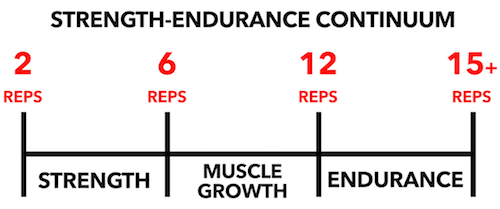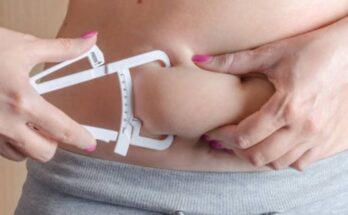If you are a professional athlete or serious about your building your physique then you must know that there is a different rep range for every goal: muscle building, strength gain, cutting or getting ripped, etc.
In this article, we’ll discuss the ideal rep range for cutting or fat loss. We will discover the best rep range during a cut which helps you in losing fat while preserving your hard-earned muscles.
But first, let’s talk about the most common mistake that people do in their cutting phase.
High Rep Range While Cutting!
This is a blindly followed strategy in the fitness world. Most people think that they should lift lightweight for tons of reps during the cutting phase.
Unfortunately, the human body doesn’t work like that.
Training in a higher rep range with lightweight doesn’t give any extra benefit for cutting or fat loss.
The burn you feel after doing a lot of reps is because of the accumulation of lactic acid in your muscles. This doesn’t mean that you are losing more fat.
So how it affects your muscles?
A high rep training (more than 12 reps per set) with lightweight increases the endurance capability of your muscles. It mainly stimulates the slow-twitch or type-1 muscle fibers.

This strategy is good if you are a long-distance runner or an endurance athlete. But it will not help you in getting toned muscles or in giving you a shredded physique.
Lifting lightweight for high reps stimulates slow-twitch muscle fibers more and boost your muscular endurance.
Downsides of high reps
If you stick to the high rep range training, you may feel very exhausted. Especially during the major compound lifts like squats and deadlifts, going for higher reps is not a good strategy.
It will also affect negatively the rest of your workout. As it is metabolically very taxing, you may not leave with enough energy for completing your training.
Hence, training in a higher rep range for cutting or fat loss is just bro-science. This strategy won’t give you any extra help in getting a ripped physique.
Ideal Rep Range For Cutting
While cutting or fat loss, you have to be on a calorie deficit diet. Due to fewer calories, there is a risk of losing some muscles too. So you should do your sets in a rep range that helps you retain the maximum muscle mass.
Hence, in your cutting phase, the best strategy is to do roughly 5-8 reps per set. You should do most of your sets in that rep range.
Does this help in burning more fat?
Well, there is no particular rep range that helps you in losing more fat. For losing fat, you have to take a caloric deficit diet or in simple terms, you have to eat fewer calories than you burn.
Read more: How To Calculate Macros For Cutting Diet?
But lifting heavy weights for fewer reps helps you in retaining the muscle mass you already have.
A study from the University of Alabama shows that “people who did high reps or just cardio lost the same amount of weight as people who lift heavy weights, but almost all the weight lost by heavy lifters was fat whereas the other group lost muscle along with fat.“
Lift heavy weights for roughly 5-8 reps. This works best for cutting while maintaining the muscles you already have.
Why this rep range is best while cutting?
Gives your muscles a reason to sustain: During the cutting phase, you consume fewer calories than you need due to which your body may lose some muscle mass along with fat. Hence, lifting heavy weights gives your muscles a reason to sustain and may grow as well.
This rep range is less taxing: During deficit, lifting lightweight for a lot of reps stimulates high metabolic fatigue. But doing a few reps with heavy weights is much less taxing.
Helps in retaining strength and power: Lifting heavy is optimal for maintaining strength while getting ripped simultaneously.
What Else Should You Do In Your Training?
Along with lifting heavy weights in a rep range of 5-8, you have to manipulate your overall training routine to burn fat while maintaining the maximum muscle mass possible.
Reduce Workout Volume
You don’t need to do a high-volume workout in your cutting phase. The total volume your muscles need during cutting vs lean bulking is much less.
Also, you are taking a caloric deficit diet, so your muscles won’t have that many glycogen stores to support a high-volume workout. And you may go into a catabolic state which leads to muscle loss.
Reduce Workout Duration
Try to finish your weight training session in roughly one hour. As you’re taking fewer than your maintenance calories, you don’t have that much of glycogen stored in your body.
Hence, doing an intense workout for a longer duration may lead your body to a catabolic state. This increases the risk of losing your hard-earned muscle mass.
Do Compound Exercises
Some people do the mistake of not doing compound exercises and focusing only on single joint or isolation exercises.
Compound exercises (squats, deadlifts, bench press, etc.) involve multiple muscles and joints. Doing these exercises burns more calories and helps you in retaining strength and muscle mass.
In addition to this, there are various benefits of compound exercises.
Do Cardio In a Different Session
Never do cardio before weight training. Do it after the weight training session or in a different session altogether.
The best strategy which I recommend to my clients is, cardio or HIIT in the morning and weight training in the evening.
Increase Workout Intensity
You should prioritize workout intensity over volume during the fat loss or cutting phase. Here are some ways to increase your workout intensity:
- Do more in less time by reducing the rest time between the sets.
- Add drop sets.
- Do your exercises in supersets or giant sets.
Let me give you an example of how you can implement this. Here’s a chest and biceps workout routine:
Barbell bench press: 5 sets 5 reps
Incline dumbbell press: 4 sets 6-8 reps
Butterflies: 3 sets 6-8 reps
Decline dumbbell fly: 3 sets 6-8 reps
Barbell curls: 5 sets 5 reps
Dumbbell hammer curls: 4 sets 6-8 reps
Preacher curls: 3 sets 8 reps
Remember, this is just a sample workout routine. You can change the exercises and number of sets as per your experience level.
Rep Range for Cutting – In A Nutshell
So this was the article explaining how many reps should you do during cutting or fat loss. To summarize:
- Do most of your sets in a rep range of 5-8 during cutting.
- Lift heavy weight and give your muscles a reason to sustain. This will also help you in maintaining strength.
- Avoid lifting lightweight for high reps. This can be a mistake during the cutting period and you might lose your muscles too.
- Add some compound exercises to your workout routine. This will help you in retaining strength and burns more fat.
- Reduce workout volume as your muscles don’t have enough glycogen to fuel a long workout.
- Reduce workout duration and increase the intensity by taking less rest or by doing supersets, drop sets, etc.
Thanks for reading this far. I hope you like the article and learned something from this. If you have any queries related to fitness, just leave a comment below.




